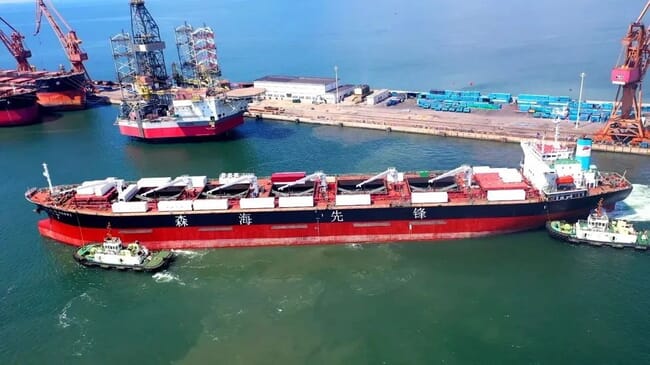
It was launched in July and is expected to produce 2,800 tonnes of fish each year © LinkedIn
China’s agricultural lands are already exploited to near-maximum levels with very little room for expansion or intensification for either crops or livestock. Similarly, its coastal waters have very limited space for the expansion of seafood production. However, it’s once-traditional aquaculture industry is experiencing a remarkable two-pronged revolution.
As Decycle New Materials CEO Chen Xi explains: “China's aquaculture industry is quickly transforming from a traditional and somewhat crude sector to a modern industry with high technology, high efficiency and a relatively low environmental load. This trend is being led by the central government, which made green agriculture and sustainable development a core strategy in recent years. There is also an increasing demand and push for more sustainable produce from younger, higher-income consumers and environmentally-conscious groups.”
Chen Xi is a keen observer of the development of the sector, working for a company is the largest producer of the filtration materials used by recirculating aquaculture systems (RAS) farms in China.
“In its first Central Document for 2023, the Chinese government ordered the construction of sea pastures to better stock its ‘blue granary’ and to develop aquaculture as an important pillar of food security. Aquaculture has also been included in the general strategy of rural revitalisation and the overall agricultural modernisation plans of the central government.”
Consequently, innovative offshore projects and a range of RAS have seen an enormous boost in recent years.
The race for space
China’s leaders realised that there is plenty of space and opportunity to produce more aquatic protein in offshore waters. With 1.4 billion people needing three meals daily, increasing seafood production there seems like a logical step to achieve long-term domestic food security.
As a result, the country has issued national guidelines to build offshore farms. It is important to understand that, while the direction of the sector and broad targets are dictated in a top-down manner by the central government, implementation is actually decentralised – meaning provinces and municipalities can decide amongst themselves how to make this happen, so long as they do make it happen.
This somewhat paradoxical freedom has resulted in a wide range of experimental designs being pilot-tested – ranging from submersible offshore structures fixed to the seabed; to floating platforms with fully enclosed cages that feature integrated hotels; to large vessels that have been redesigned to serve as offshore fish farms.
Two of the latest projects really stand out.
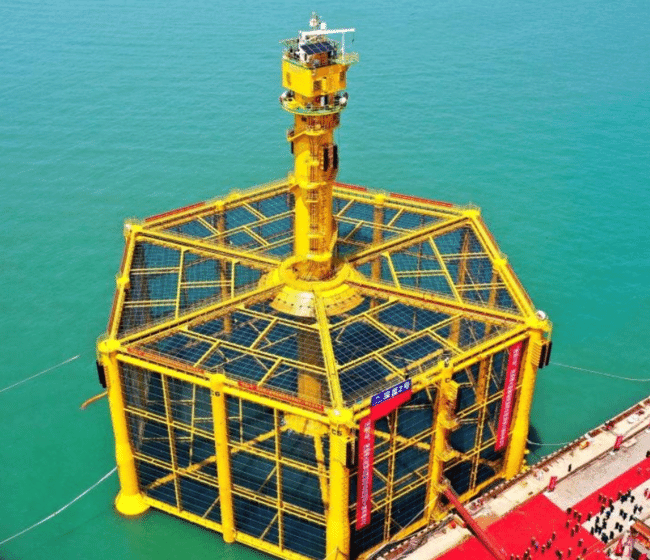
© X
The gargantuan ‘Shenlan-2’ farm, launched in January 2024, is a submersible cage structure 20-storeys tall, which can reportedly hold up to a million salmon. An improvement over the already-successful ‘Shenlan-1’ design launched in 2018, ‘Shenlan-2’ is reliant on AI – most of the farm’s systems, including feeding, hydrological and meteorological checks, lighting and biomass monitoring are optimised by computers – making it a contender for the world’s most advanced fish farm.
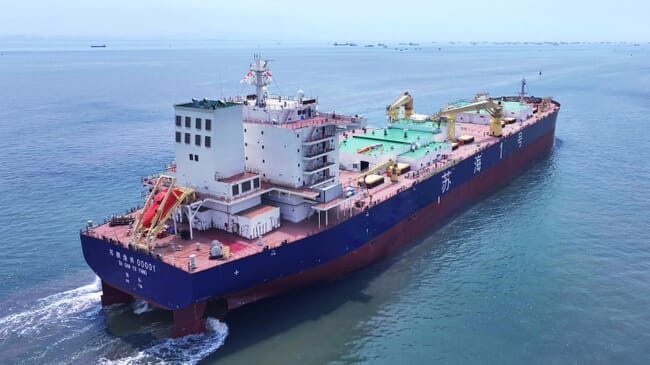
A completely different approach to offshore farming is the recently launched Su Gan Yu Yang, dubbed ‘Suhai No. 1’, which was launched in April 2025.
As Zhongde Huang, a Chinese aquaculture expert and board member for R&D at the Center for Deep Sea Fish Life Support Systems, explains: “This 250 metre-long vessel is expected to operate in the colder waters of the Yellow Sea and eventually aims to produce over 8,000 tonnes of salmon annually, with an estimated annual output value of $70 million. It holds 83,000 cubic metres of culture volume and is completely digitally monitored.” These production figures seem to be somewhat too optimistic but nevertheless it is a very promising concept.
“The project is a collaboration between different local businesses and the municipal government,” adds Huang. “The vessel was designed by the Institute of Fishery Machinery and Instruments of the Chinese Academy of Fishery Sciences and was built by Guangzhou Huangpu Wenchong Shipyard in early 2023 at a total cost of nearly $80 million.”
A key player that is emerging in the development of offshore aquaculture in China is CIMC Raffles. In the past four years alone, the company has produced and installed 25 offshore fish farm platforms, 12 deep-sea aquaculture cage projects and 1 deep-water aquaculture vessel. Interestingly, these farms produce a wide range of species, including grouper, pompano, salmon, yellow croaker and amberjack. The target of the company is to develop 100 offshore projects by 2030.
Much is expected of the offshore subsector in the coming two years as new and updated designs are being launched on an almost monthly basis.
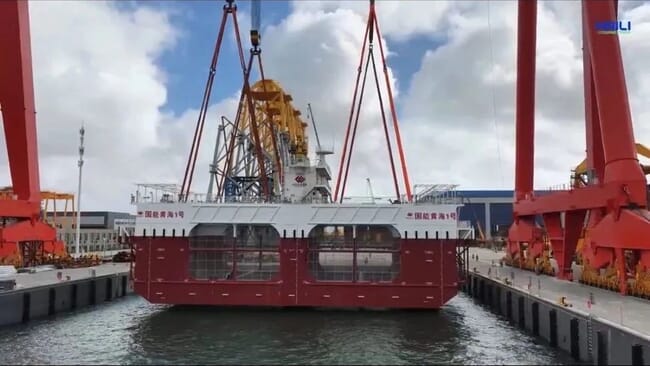
Constructed by Jiangsu Haili Wind Power, it was launched on 20 July in Jiangsu Province © LinkedIn
A recirculation nation
Meanwhile, on land, Chen Xi notes how China is pushing its producers towards more sustainable farming practices.
“According to the Law on Prevention and Control of Water Pollution and Law on Protection of the Marine Environment, aquaculture farmers must meet discharge standards. Exceeding these discharge standards merits punishment, with a maximum fine of RMB 500,000 [$69,000]. More importantly, government departments will be directly held accountable for regulatory failures.”
“It also has greatly helped that a government paper named Several Opinions on Accelerating the Green Development of Aquaculture, which was jointly issued by ten ministries and commissions in 2019, explicitly recommended support for all farms that embrace RAS technology,” she adds.
Consequently, RAS farms have become a key area of financial support for local governments and national agencies.
“Consumers, especially younger, high-earning consumers, have started to demand safe, drug-free aquatic products – meaning there is an increasingly strong local market for RAS-farmed seafood.”
This strong government push, coupled with a solid local market, has caused a boom in ambitious RAS projects across the country. One of the projects that stands out is Ze Hui Aquaculture’s new RAS facility for eels. Its facilities span 520,000 square meters and include 560 grow-out tanks, a processing plant, a feed mill and a research laboratory. Check out a video of its impressive facilities here.
The company spared no expense and worked with the likes of Billund Aquaculture, Oxyguard, Ultraqua and several other leading equipment manufacturers. With an investment of almost $300 million, the company aims to churn out 15,000 tonnes of eel yearly. Its first batch breached 5,000 tonnes, was valued at $71 million and hit the shelves at the end of 2022.
Several leading feed and aquaculture producers have also decided to go all-in for RAS shrimp farming in China. Four leading players – CP, Evergreen, Tongwei and Haida – have between them constructed eight large RAS growout farms that hold two million cubic metres of water, with a targeted annual output of 70,000 tonnes.
China’s smaller shrimp farms are equally ambitious and try to be cost-effective by thinking out of the box – making the most of their innovative and hugely successful lined greenhouse ponds with filtration that make tropical shrimp farming possible and cost-effective in the colder regions in China. With an average 80 percent survival rate, a return on investment might be expected within a single year.
Another interesting approach that stands out is Luyu Aquaculture, which has bet big on AI. The company operates eight facilities spread across the country. The data from these facilities feed a single large AI model that helps in decision-making processes for daily operations, giving it an edge over many producers. Watch out a video of their operations here.
For investors and farmers, an added advantage is that the cost of a typical RAS system in China is only about 20 to 30 percent of the price of typical Western systems. The setup involves far fewer suppliers and manufacturers. Another big difference is that many systems are readily available without major waiting times. Simply check out the Alibaba platform to get a sense of what’s on-hand now.
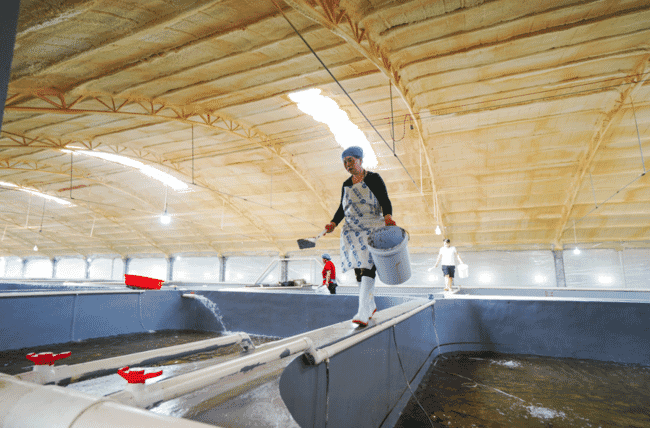
© Shutterstock
Financing
Few financial details are available for these ambitious offshore and RAS projects, making some outside experts question the economic viability of these initiatives. Leading offshore aquaculture expert Alan Cook keeps a close eye on developments in China and recently came up with an analysis that compares the required investments of China’s ambitious offshore projects with well-known salmon RAS projects in the west.
His analysis shows that there is a very similar capex per kilogram of capacity, but he suggests China’s strategy is more likely to triumph. “While the West dithers, the East goes ahead building assets and more importantly, building knowledge on offshore farming,” Cook argues.
Chen Xi adds that, in terms of financing, there are diverse backers for the offshore farms.
“Government subsidies tend to reach up to 30 to 40 percent of the investment cost of a new project, while the bulk – from 50 percent to 60 percent – is provided through self-financing by enterprises and market-based financing, with the remaining 10 percent to 20 percent typically filled by commercial loans.”
What’s next?
There’s so much that the aquaculture world can learn from China if they are open to it. Only by visiting China and seeing first-hand what it is doing at sea can one comprehend not just the sheer scale of its fish farms, but also its iron-cored sense of purpose.
From a developing nation into the 1980s into the economic powerhouse it is today, China’s transformation from the mere mass-production of seafood into a research and pilot-testing hub for next-level fish farming solutions should ensure its global aquaculture dominance for decades to come.
As Cook adds “While we wring our hands over ESG metrics and permitting delays, China is quietly launching state-backed, offshore aquaculture vessels that will change the face of aquaculture in the near future. This isn't just about salmon. It's about food sovereignty, industrial strategy, and who controls the next generation of protein supply. Here's what happens when a country with long institutional memory and industrial discipline decides to build the future of food.”
With China blazing the trail, many nations can adopt and modify the best farm designs and policy approaches, not just to provide food for all – but to produce it in harmony with the water.
Aside from The Fish Site’s interviewees for this story, we wish to thank Zhibin Lyu, who produces and distributes moving bed biofilms around the world.
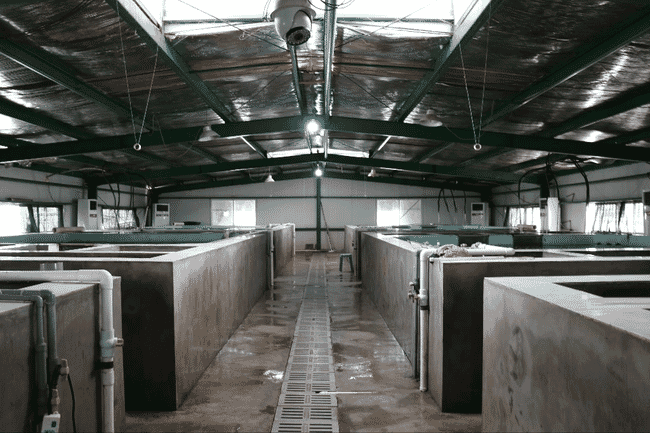
© Chen Xi




